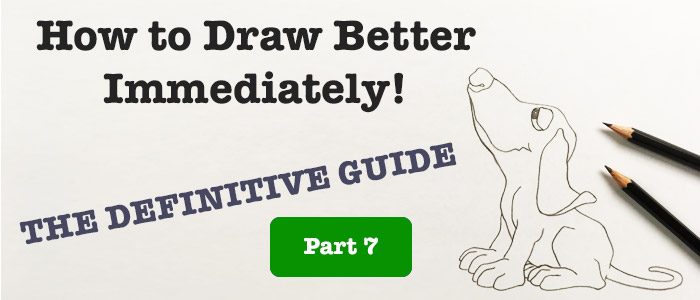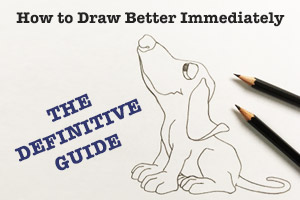
This is part 7 of the series How to Draw Better Immediately – The Definitive Guide.
“Okay”, I hear you say, “so how do I actually use my natural abilities, comparison skills and the Artist’s Language to draw something?”. First of we’ll take a look at the general principles, then look at some actual examples of the Artist Language in the sections which follow:
Creating an Outline Drawing
When creating an artwork you will often start with an outline drawing that includes sketches of the object’s boundaries, as well as the major shadow and highlight areas.
During this part of the drawing process you will use your Artist’s Language to access your skills relating to:
- Comparison of angles
- Comparison of sizes
Shading your Drawing
Once you are satisfied with the different components of your outline drawing, you will add the various levels of tones to the drawing by using shading.
In doing all of this you will be using the Artist’s Language to access your skills relating to comparison of tones.
Placing Objects within the Image (Composition)
Furthermore, in the overall process of composing a complete and entirely original artwork, you will also be accessing your Artist’s Language to help in comparing spaces, as you consider where to place objects in the image.
Naturally combining your skills
When using the Cindy Wider Method and the Artist’s Language, you will start by comparing just one angle, one tone, one area of space or the size of one shape or line to another. But over time, you will naturally develop the skills necessary to combine several of these comparison skills synergistically and use them naturally without even thinking about it. You will one day just find yourself drawing.
Once you have made this initial comparison of just one angle (for example), you will be able to recall this information and apply it to your drawing.
Let’s imagine that you are drawing a specific angle, it’s important to first of all work out what angle it is, by comparing it to the sides of your page (this is when you are accessing the Artist’s Language.) Then you will need to keep that angle in your memory before sketching the same angle onto your page. Then you will begin darting your eyes back and forth several times between the object and the image to check it is correctly recorded.
You can also lay your pencil on the angle to check it for accuracy against the image you are drawing from.
It’s important to spend more time (approximately 80%) observing the subject (i.e. your object), as compared to time spent placing pencil to paper. This means that you will spend a relatively brief period of time looking at your paper, when sketching what you have observed in your subject (at least in the early stages of the drawing.)
Checking Your Accuracy
During this process you can go back and double check the accuracy of the angle by laying your pencil onto the paper, as long as the page and the reference source are parallel to one another. You can repeat the same process when drawing from life, as long as you remain in the same physical position throughout the whole drawing. This process of comparing angles, sizes, tones and spaces is important during the early stages of developing drawing skills.
Getting in the Zone
As you get ‘into the zone’ for drawing, you will find yourself working from your subconscious mind; and closer to the final stages of the drawing you will spend more time developing the artwork based upon your deeper knowledge of the subject. This is also the exciting time during which you can add unique touches of self-expression to your artwork, as you build the image up to completion.
Tip! Making the Switch
Whenever you first begin your drawing sessions, you will probably be in your ‘everyday life’ mode of thinking. This means that your thoughts could be about your work, house, kids, partner, pets, or whatever else might be going on in your world besides drawing.
You will find that you can immediately remove yourself from these distractions if you use the Artist’s Language when you initially sit down to draw. It’s easier to remember the comparison you have just made, if you speak it out loud, rather than just look at it in an abstract way!
Next: Helpful Comparison Questions to Use for your Artists Language


